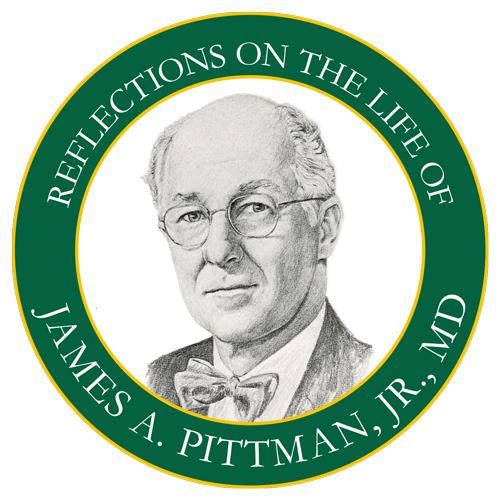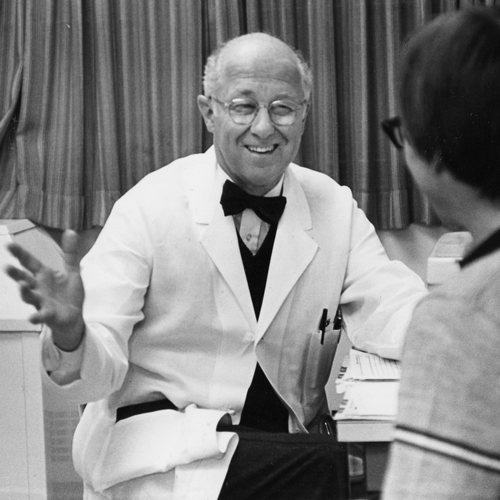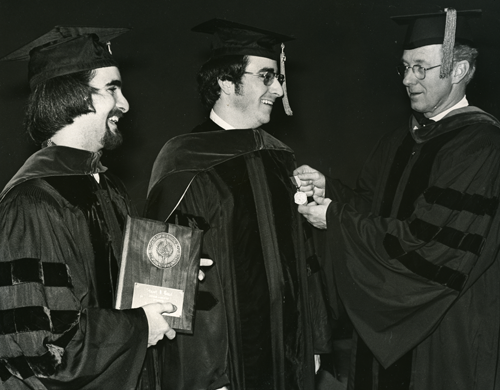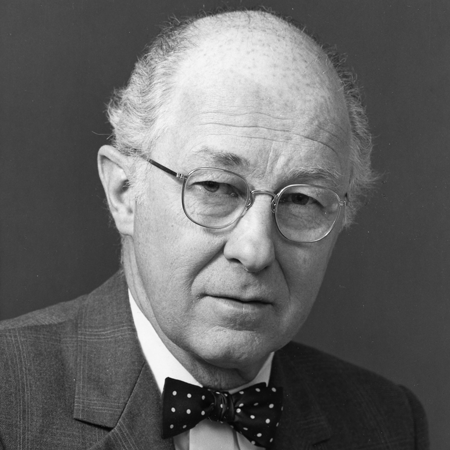 Although I knew Dr. James A. Pittman, Jr., by reputation when I began my third year at the Medical College of Alabama in 1963, I did not meet him face to face until the second month of my internal medicine clerkship in July 1963. I was assigned to present a patient to Dr. Pittman during student attending rounds the next day, without the support of the interns or resident on our service. I do not recall the specific patient or his clinical problems, but I do know that I spent the remainder of that day and evening preparing.
Although I knew Dr. James A. Pittman, Jr., by reputation when I began my third year at the Medical College of Alabama in 1963, I did not meet him face to face until the second month of my internal medicine clerkship in July 1963. I was assigned to present a patient to Dr. Pittman during student attending rounds the next day, without the support of the interns or resident on our service. I do not recall the specific patient or his clinical problems, but I do know that I spent the remainder of that day and evening preparing.
Entering the conference room the next day, I was anxious but confident that I was well-prepared to impress Dr. Pittman with my knowledge of the patient and his problems -- until Dr. Pittman abruptly asked me to draw the structure of cortisone and hydrocortisone on the blackboard. I desperately tried to remember my biochemistry, and fumbled around trying to put the correct structures together, until Dr. Pittman bailed me out by getting up and drawing the structures himself. He did not criticize me or embarrass me in the process, which I sincerely appreciated, though I felt I had definitely disappointed him.
As I came to know Dr. Pittman better in the ensuing years, I realized that one of his strongest traits was to motivate everyone he worked with to be the best they could be, without any shred of intimidation. He truly cared about others and took pride in seeing them reach their full potential. I believe he thrived on the success of those who worked under him. Years later, when I recounted the above patient presentation to Dr. Pittman, he did not recall it, but he did say, “Surely I did not ask an anxious, inexperienced third-year medical student to draw steroid hormone structures on the blackboard during one of his first patient presentations.” And he actually apologized to me for doing so.
After internal medicine residency at Mayo Graduate School of Medicine – interrupted by two years in the United States Air Force – my wife, Armanda, and I returned to Birmingham, where I completed an additional year of internal medicine residency at Carraway and then entered endocrinology fellowship at UAB in 1970. At that time, Dr. Pittman and his colleague, Dr. Jerome Hershman, were excited by recent developments in neuroendocrinology, including the discovery of the structure of, and ultimately the biosynthesis of, thyrotropin-releasing hormone or TRH, in 1969, by Roger Guillemin and Andrew Schally, who subsequently shared the 1977 Nobel Prize in Physiology or Medicine with Rosalyn Yalow. Drs. Pittman and Hershman were working with Charles Baugh in UAB’s nutrition division, who had synthesized TRH for local use in clinical investigation trials.
 I was excited by these developments, as well, but also had a strong interest in clinical endocrinology. Dr. Pittman assured me that I could actively participate in traditional clinical activities and begin work on assessment of the usefulness of TRH in evaluation of the hypothalamic-pituitary-thyroid axis in patient care. Initially I reported directly to Dr. Pittman; with his and Dr. Hershman’s guidance and support, we rapidly accumulated data on the response to TRH in normal subjects and in those with a broad spectrum of thyroid abnormalities. Our findings were accepted for presentation at a focus group of the regional meeting of the American Federation for Clinical Research (now the American Federation for Medical Research).
I was excited by these developments, as well, but also had a strong interest in clinical endocrinology. Dr. Pittman assured me that I could actively participate in traditional clinical activities and begin work on assessment of the usefulness of TRH in evaluation of the hypothalamic-pituitary-thyroid axis in patient care. Initially I reported directly to Dr. Pittman; with his and Dr. Hershman’s guidance and support, we rapidly accumulated data on the response to TRH in normal subjects and in those with a broad spectrum of thyroid abnormalities. Our findings were accepted for presentation at a focus group of the regional meeting of the American Federation for Clinical Research (now the American Federation for Medical Research).
We continued to accumulate data and submitted an abstract for presentation at the national meetings of the AFCR and American Society for Clinical Investigation (ASCI) later in spring 1971. We were surprised when it was accepted for presentation at an AFCR plenary session.
Although I rehearsed before colleagues, I was definitely intimidated to present to a larger, more prestigious audience, and asked Dr. Pittman if I should get a haircut. He just smiled and said he did not think that would be necessary. I understood the humor in that question when I finally made it to the meeting in Atlantic City. Long hair and beards were common among the attendees; it was academia in 1971, after all.
While I was there, several experiences enhanced my understanding of and admiration for Dr. Pittman. I had been led to believe I would be the only member of our division present. This increased my anxiety because of my inexperience and my suspicion that competing investigators would be in attendance and loaded for bear. Sensing my concern, Dr. Pittman came by to tell me that he had decided to go to Atlantic City and would be in the audience for my presentation.
When the time for my presentation arrived, I nervously climbed the stairs to the stage and looked out at the audience of more than 2,000. Dr. Bob Kreisberg was moderator, and immediately put me at ease when he whispered an invitation to dinner with others from UAB that evening. That, and Dr. Pittman’s presence, settled me down, and, with a steady flow of adrenaline, the presentation went very well, even though I realized several of those who posed questions to me were investigators I had just quoted.
After dinner with Drs. Pittman, Bob Kreisberg, Glenn Cobbs, Kirk Avent, John Harris and Charles Mackey, Dr. Pittman introduced me to a number of thyroidologists from a variety of prestigious universities, many of whom I recognized as prominent investigators. He made me feel that he was genuinely proud of me and my presentation earlier in the day, seemingly enjoying our success more than even I did.
After returning from Atlantic City, we expanded our studies on TRH. With Dr. Pittman’s and Dr. Hershman’s guidance, that work resulted in several publications in peer-reviewed journals, with Dr. Pittman insisting that I was listed as first author on most of them. These articles were instrumental in allowing me to gain fellowship status in the American College of Physicians and membership in the American Thyroid Association and the Endocrine Society at a relatively young age, for which I will always be grateful.
 Early in my second year of fellowship, Dr. Pittman asked me to help him with a book on preparation for the certifying examination in internal medicine. I was honored to be asked, especially since I was preparing to take the American Board of Internal Medicine’s certifying examination within several months. The requested format was to write multiple choice questions that were relevant to internal medicine, to divide them into chapters pertinent to the various subspecialties of internal medicine and to provide an answer key for the questions we wrote, all within a relatively tight time frame. I began to incorporate this project into my own study plan for the board examination, expecting to assist with the book’s preparation.
Early in my second year of fellowship, Dr. Pittman asked me to help him with a book on preparation for the certifying examination in internal medicine. I was honored to be asked, especially since I was preparing to take the American Board of Internal Medicine’s certifying examination within several months. The requested format was to write multiple choice questions that were relevant to internal medicine, to divide them into chapters pertinent to the various subspecialties of internal medicine and to provide an answer key for the questions we wrote, all within a relatively tight time frame. I began to incorporate this project into my own study plan for the board examination, expecting to assist with the book’s preparation.
Shortly after getting started, Dr. Pittman announced that he had accepted an appointment with the Veteran’s Administration Central Office in Washington, D.C. I was somewhat startled to hear this and asked Dr. Pittman if we were going to abandon the review book project. He responded by asking if I wanted to take on primary responsibility for the project. With ongoing research and getting ready for my own board examination, I was somewhat overwhelmed by the thought of singlehandedly taking on responsibility for the book.
As usual, Dr. Pittman was at least one step ahead of me. He contacted his younger brother, Dr. Joe Pittman, an internist in private practice in Rockford, Ill., who agreed to work with me. We ultimately finished two editions. I successfully passed my internal medicine boards in the process, and I vowed to never doubt Dr. Pittman again.
On February 7, 1972, Armanda and I had a beautiful baby girl whom we named Susan Talmadge Haigler. The next day, our pediatrician, Dr. Edward Goldblatt, heard a heart murmur and asked Dr. Lionel Bargeron to evaluate our new baby. Dr. Bargeron determined that she had a bicuspid, stenotic aortic valve, and at just two days old, she underwent cardiac bypass surgery. Everything went smoothly at first, but a few days later, there was evidence of bleeding into the mediastinum, and she was taken back to surgery. She died early in the morning of February 14. A lot of what happened at that time is a blur, but one thing is crystal clear. The morning of Susan’s funeral, we received a telephone call from Dr. Pittman, who was now working at the VA Central Office in Washington, DC. He spoke with me and then asked to speak with Armanda. We were both deeply touched by the personal, sincere nature of his comments to us and his obvious and genuine concern, which provided great compassion, comfort and support to us. This experience gave us a glimpse into Dr. Pittman’s character and personality we had not seen before, and we both had a tremendous respect for him and considered him our friend from that day forward.
I completed my endocrinology fellowship in June 1972, and began my practice in internal medicine and endocrinology at Norwood Clinic and Carraway Methodist Medical Center. In 1973, I was appointed Program Director for the CMMC Internal Medicine Residency program. At some point in the early 1970s, I answered a page while making medical round; it was Dr. Pittman, who asked if I would be interested in becoming assistant dean for graduate medical education at UAB. Armanda and I thought about it, but in the end, we decided to continue my career at Norwood Clinic and CMMC, both of which had a long and proud history of support for graduate medical education and had reaffirmed their commitment to continue that support.
I received another call from Dr. Pittman in 1976. He proposed a new committee, the Birmingham Medical Education Coordinating Committee, with representation from hospitals that had an ongoing commitment to medical and graduate medical education. He asked if I would serve as the inaugural chair. I was honored and quickly agreed. So, basically, Dr. Pittman got me to volunteer to chair this new committee after I had not pursued his tentative offer of a paid assistant dean’s position. I am not sure whether this was more a testimony to his management and leadership skills, or to my lack of business acumen, but Dr. Pittman always had a knack for getting people to do exactly what he needed them to do.
I always wondered how my career would have evolved if I had returned to UAB when Dr. Pittman contacted me back in the early 1970s. I am absolutely certain there would have never been a medical school deanship in my future, but I would have been honored to work directly again with Dr. Pittman, who I now felt comfortable addressing as Jim. During Jim Pittman’s 19-year tenure as dean, our paths crossed on many occasions, and we worked together on a number of areas of common interest.
Jim Pittman was my mentor and an extremely important person in my life. He meant a great deal to Armanda and me. I am not sure we ever directly said that to him, but he will always have our gratitude and admiration for the role he played in our lives.
